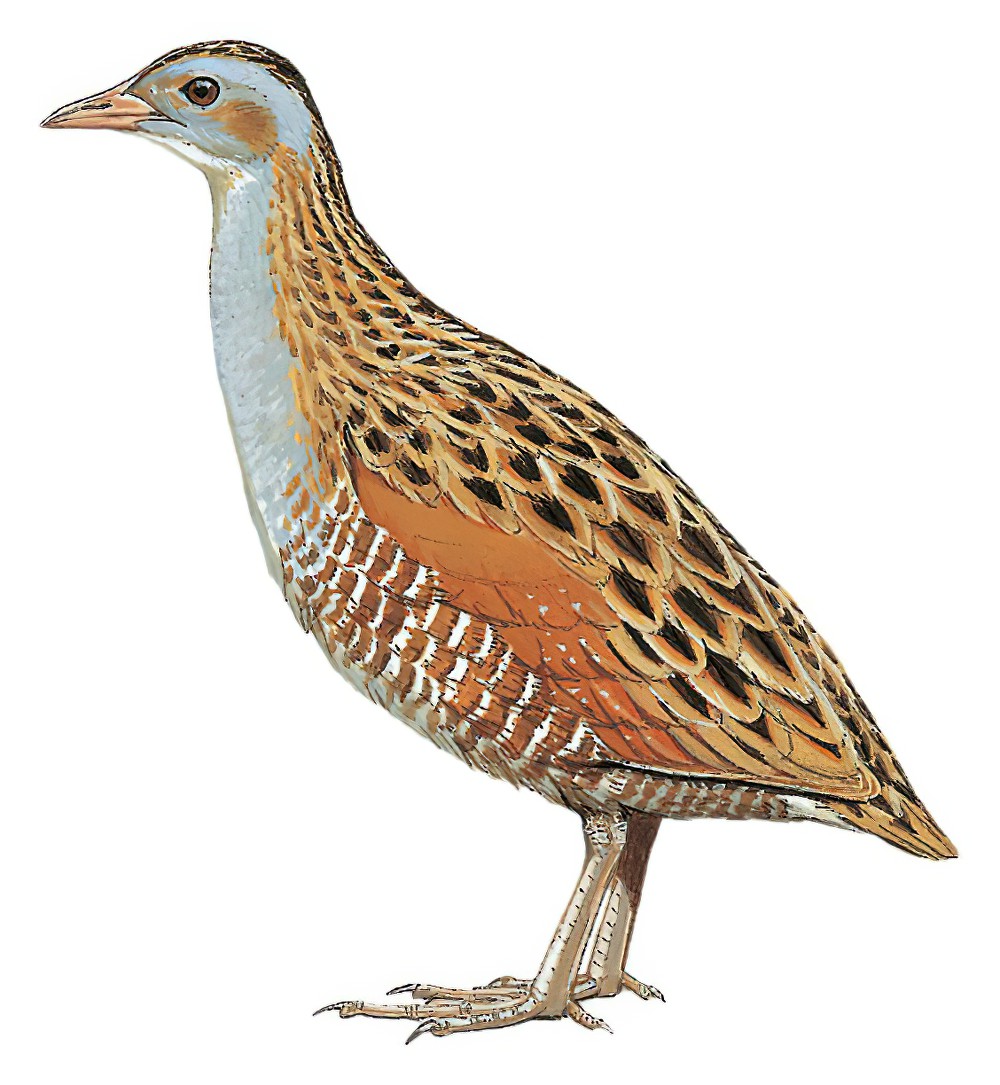Corn Crake / Crex crex

Corn Crake
SCI Name:
Protonym: Rallus Crex Syst.Nat.ed.10 p.153
Taxonomy: Gruiformes / Rallidae / Crex
Taxonomy Code: corcra
Type Locality: Europe, restricted type locality Sweden, ex Fn. Svec.
Author: Linnaeus
Publish Year: 1758
IUCN Status: Least Concern
DEFINITIONS
CREX
(Rallidae; Ϯ Corncrake C. crex) Specific name Rallus crex Linnaeus, 1758; "LIIII. Gattung: Knarrer. Crex. Schnabel: Kurz, an den Seiten zusammengedrückt, fast bis an die Spitze gleich breit. Nasenlöcher: Länglich, in der Mitte des Schnabels. Füße: Mit mittelmäßig langen getrennten Zehen. Leib: Zusammengedrückt. Diese Gattung hält das Mittel zwischen der vorhergehenden [Rallus] und nachfolgenden [Gallinula] in Lebensart, Schnabel und Fußform. * 1. Wiesenknarrer (Wachtelkönig: C. pratensis, mihi) ... Rallus Crex, Linné." (Bechstein 1803); "Crex Bechstein, Orn. Taschenb. Deutschl, Th. 2, 1803, p. 336. Type, by monotypy and tautonymy, Crex pratensis Bechstein = Rallus crex Linné." (Peters, 1934, II, p. 181). In former days the rasping call of the Corncrake was commonly heard in Britain, but its numbers and distribution have dramatically shrunk due to changed farming practices and loss of habitat.
Synon. Crecopsis, Ortygometra.
crex
● Gr. κρεξ krex, κρεκος krekos noisy braggart (subsp. Cincloramphus timoriensis).
● Gr. κρεξ krex, κρεκος krekos long-legged bird mentioned by Herodotus, Aristophanes, Aristotle, and other authors, since identified with a wide variety of birds, including the Corncrake (on the assumption that the name is onomatopoeic, as indicated by Linnaeus); "83. RALLUS. ... Crex. 1. R. alis rufo-ferrugineis. Ortygometra alis rufo-ferrugineis. Fn. svec. 162. Ortygometra. Aldr. orn. l. 13. c. 23. Will. orn. 522. t. 29. Raj. av. 58. Alb. av. I. p. 30. t. 32. Habitat in Europæ agris, carectis; victitat Lumbricis. Corpus valde compressum; vesperi & nocte sonorus voce ingeminata crex." (Linnaeus 1758) (Crex).
CREX
(Rallidae; Ϯ Corncrake C. crex) Specific name Rallus crex Linnaeus, 1758; "LIIII. Gattung: Knarrer. Crex. Schnabel: Kurz, an den Seiten zusammengedrückt, fast bis an die Spitze gleich breit. Nasenlöcher: Länglich, in der Mitte des Schnabels. Füße: Mit mittelmäßig langen getrennten Zehen. Leib: Zusammengedrückt. Diese Gattung hält das Mittel zwischen der vorhergehenden [Rallus] und nachfolgenden [Gallinula] in Lebensart, Schnabel und Fußform. * 1. Wiesenknarrer (Wachtelkönig: C. pratensis, mihi) ... Rallus Crex, Linné." (Bechstein 1803); "Crex Bechstein, Orn. Taschenb. Deutschl, Th. 2, 1803, p. 336. Type, by monotypy and tautonymy, Crex pratensis Bechstein = Rallus crex Linné." (Peters, 1934, II, p. 181). In former days the rasping call of the Corncrake was commonly heard in Britain, but its numbers and distribution have dramatically shrunk due to changed farming practices and loss of habitat.
Synon. Crecopsis, Ortygometra.
crex
● Gr. κρεξ krex, κρεκος krekos noisy braggart (subsp. Cincloramphus timoriensis).
● Gr. κρεξ krex, κρεκος krekos long-legged bird mentioned by Herodotus, Aristophanes, Aristotle, and other authors, since identified with a wide variety of birds, including the Corncrake (on the assumption that the name is onomatopoeic, as indicated by Linnaeus); "83. RALLUS. ... Crex. 1. R. alis rufo-ferrugineis. Ortygometra alis rufo-ferrugineis. Fn. svec. 162. Ortygometra. Aldr. orn. l. 13. c. 23. Will. orn. 522. t. 29. Raj. av. 58. Alb. av. I. p. 30. t. 32. Habitat in Europæ agris, carectis; victitat Lumbricis. Corpus valde compressum; vesperi & nocte sonorus voce ingeminata crex." (Linnaeus 1758) (Crex).
UPPERCASE: current genus
Uppercase first letter: generic synonym
● and ● See: generic homonyms
lowercase: species and subspecies
●: early names, variants, mispellings
‡: extinct
†: type species
Gr.: ancient Greek
L.: Latin
<: derived from
syn: synonym of
/: separates historical and modern geographic names
ex: based on
TL: type locality
OD: original diagnosis (genus) or original description (species)












